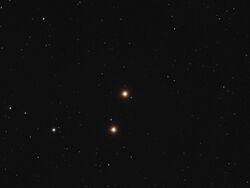Astronomy:Nu1 Coronae Borealis
| Observation data Equinox J2000.0]] (ICRS) | |
|---|---|
| Constellation | Corona Borealis |
| Right ascension | 16h 22m 21.42545s[1] |
| Declination | +33° 47′ 56.5825″[1] |
| Apparent magnitude (V) | 5.20[2] |
| Characteristics | |
| Spectral type | M2 III[3] |
| B−V color index | 1.64[3] |
| Astrometry | |
| Radial velocity (Rv) | −13.17±0.35[4] km/s |
| Proper motion (μ) | RA: +4.265[1] mas/yr Dec.: −37.877[1] mas/yr |
| Parallax (π) | 5.0069 ± 0.1323[1] mas |
| Distance | 650 ± 20 ly (200 ± 5 pc) |
| Absolute magnitude (MV) | −1.19[3] |
| Details | |
| Radius | 67.1±7.1[5] R☉ |
| Luminosity | 975±30[1] L☉ |
| Temperature | 3,936+565 −295[1] K |
| Other designations | |
| Database references | |
| SIMBAD | data |
Nu1 Coronae Borealis is a solitary,[7] red-hued star located in the northern constellation of Corona Borealis. It is faintly visible to the naked eye, having an apparent visual magnitude of 5.20.[2] Based upon an annual parallax shift of 5.0 mas,[8] it is located roughly 650 light years from the Sun. At that distance, the visual magnitude is diminished by an extinction of 0.1 due to interstellar dust.[9] This object is drifting closer with a radial velocity of −13 km/s.[4]
This is an evolved red giant star with a stellar classification of M2 III.[3] It is a variable star of uncertain type, showing a change in brightness with an amplitude of 0.0114 magnitude and a frequency of 0.22675 cycles per day, or 4.41 days/cycle.[10] It has about 67[5] times the Sun's radius and is radiating 975 times the Sun's luminosity from its photosphere at an effective temperature of 3,936 K.[1]
References
- ↑ 1.0 1.1 1.2 1.3 1.4 1.5 1.6 1.7 Brown, A. G. A. (August 2018). "Gaia Data Release 2: Summary of the contents and survey properties". Astronomy & Astrophysics 616: A1. doi:10.1051/0004-6361/201833051. Bibcode: 2018A&A...616A...1G. Gaia DR2 record for this source at VizieR.
- ↑ 2.0 2.1 Ducati, J. R. (2002), "VizieR Online Data Catalog: Catalogue of Stellar Photometry in Johnson's 11-color system", CDS/ADC Collection of Electronic Catalogues 2237, Bibcode: 2002yCat.2237....0D.
- ↑ 3.0 3.1 3.2 3.3 Huang, W. et al. (2012), "A catalogue of Paschen-line profiles in standard stars", Astronomy & Astrophysics 547: A62, doi:10.1051/0004-6361/201219804, Bibcode: 2012A&A...547A..62H.
- ↑ 4.0 4.1 de Bruijne, J. H. J.; Eilers, A.-C. (October 2012), "Radial velocities for the HIPPARCOS-Gaia Hundred-Thousand-Proper-Motion project", Astronomy & Astrophysics 546: 14, doi:10.1051/0004-6361/201219219, A61, Bibcode: 2012A&A...546A..61D.
- ↑ 5.0 5.1 Dyck, H. M.; Benson, J. A.; Van Belle, G. T.; Ridgway, S. T. (1996), "Radii and Effective Temperatures for K and M Giants and Supergiants", The Astronomical Journal 111 (1): 521–533, doi:10.1086/117910, Bibcode: 1996AJ....111.1705D.
- ↑ "nu01 CrB". SIMBAD. Centre de données astronomiques de Strasbourg. http://simbad.u-strasbg.fr/simbad/sim-basic?Ident=nu01+CrB.
- ↑ Eggleton, P. P.; Tokovinin, A. A. (September 2008), "A catalogue of multiplicity among bright stellar systems", Monthly Notices of the Royal Astronomical Society 389 (2): 869–879, doi:10.1111/j.1365-2966.2008.13596.x, Bibcode: 2008MNRAS.389..869E.
- ↑ van Leeuwen, F. (2007), "Validation of the new Hipparcos reduction", Astronomy and Astrophysics 474 (2): 653–664, doi:10.1051/0004-6361:20078357, Bibcode: 2007A&A...474..653V.
- ↑ Famaey, B. et al. (January 2005), "Local kinematics of K and M giants from CORAVEL/Hipparcos/Tycho-2 data. Revisiting the concept of superclusters", Astronomy and Astrophysics 430 (1): 165–186, doi:10.1051/0004-6361:20041272, Bibcode: 2005A&A...430..165F.
- ↑ Koen, Chris; Eyer, Laurent (2002), "New periodic variables from the Hipparcos epoch photometry", Monthly Notices of the Royal Astronomical Society 331 (1): 45–59, doi:10.1046/j.1365-8711.2002.05150.x, Bibcode: 2002MNRAS.331...45K.
 |


